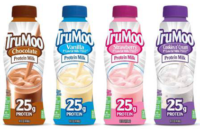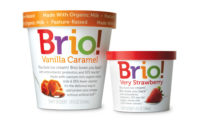
Health Focus
By Lori Dahm
The current climate of wellness drives the latest
developments in dairy ingredients.
Convenience and health have been the major driving
factors within the dairy category over the past year. The result has been
twofold: Yogurt continues to benefit from a health halo effect as consumers
are embracing yogurt products as inherently good for them. The second
result gaining significant momentum is that dairy-based beverages,
particularly smoothies, are experiencing a boom.
The ingredients that are making their way into
formulations of these types of products are innovative, improved and worth
noting. For example, live active cultures and probiotics are finally
gaining a foothold in the dairy case as many yogurt products incorporate
these bacteria. Also, many of the dairy-based beverages are fortified or
otherwise enhanced with vitamins and minerals, or feature an additional
protein boost. And the ingredients that are also necessary for
functionality in these beverages — such as the stabilizers, gums and
texturizers — are being improved to work in tandem with the myriad of
ingredients that are now contained in that single-serve smoothie
bottle.
Then there is the whole world of whey protein, which
may be the promised land for dairy ingredients. Given the cutting-edge
research that suggests the veritable health powerhouse that is contained in
whey, the potential of whey ingredients is vast and promises to only
increase in the near future.
Dairy continues to be a dynamic category that responds
to trend fluctuations with promises of health benefits and products that
can meet the consumer demand for convenience. And the suppliers and
manufacturers to the industry continue to improve ingredients and
formulations so that product performance is accelerated to meet consumer
expectations.
Whey to Go
The biggest news within the dairy industry might be
focused upon whey as an ingredient. Whey’s necessary result as a
byproduct of cheese was a bane of the dairy industry until researchers
started investigating the benefits of whey itself about a decade ago. The
body of research supporting whey’s functionality and health benefits
has now reached the level at which whey is starting to emerge into public
awareness.
“There is a groundswell in awareness about whey,
where we are starting to see articles appear in the popular press and in
consumer media here and there, verifying the health benefits that whey
offers,” says Bill Haines, industry consultant and former vice
president of innovation at Dairy Management Inc., Rosemont, Ill.
“Whey has always enjoyed a history of great interest among athletes
and body builders for its benefits, and we are starting to see that same
interest spill over into the general public. There is no question that whey
protein and whey-derived ingredients have finally gotten off the
ground.”
As stand-alone products, whey protein has been a part
of the body builder’s regime for a long time. Due to the metabolic
and muscle-building capacities that whey protein has, now whey ingredients
are making a significant showing in energy bar applications as well.
But the biggest area of excitement for whey is in
beverages. Whey protein ingredients and whey concentrates are being used to
increase the health quotient in beverages at a time when beverages that
provide only “empty calories” are coming under fire.
“The real excitement in the use of whey
ingredients is in beverages, where we are seeing beverage manufacturers use
these ingredients to make refreshing, convenient beverages also healthy. So
a juice drink or a soft drink might incorporate a whey ingredient,”
Haines says. “This upgrades the nutritional profile of these
conventional beverages beyond simply quenching thirst. A lot of this
movement stems from the fact that these beverage manufacturers are under
pressure to demonstrate that they do have public health and wellness in
mind, so they are searching for ways to make convenient products also offer
protein or calcium.”
In fact, the category of functional beverages that are
dairy-based with nutraceutical ingredients to allow for health claims is an
area that will experience significant growth over the next few years. The
smoothie-type beverages are one manifestation of this trend, wherein
consumers are looking for nutritious beverages that boast health benefits,
and the convenience of drinking on the go means that smoothie products find
their way into consumer lifestyles easily. Whey ingredients will likely be
a big component in the formulation of these products in the future.
“Right now manufacturers are incorporating more
whey ingredients into products for their health benefits, although the
industry is still being careful about making specific health claims for
whey. This is probably a wise caution, because there is still the need to
conduct a lot more human clinical work to substantiate the health benefits
that are starting to be documented,” Haines says. “The one
exception might be the hydrolyzed whey protein and its ability to regulate
blood pressure, which is already on a label claim in many products in
Europe. This is a sign of what is to come in the world of whey ingredients,
with significant human research being conducted in other areas.”
One development in the past year in the world of whey
ingredients is that for the first time in decades, there was a global
shortage of whey, and the U.S. dry milk ingredient supply was in high
export demand. New Zealand, which is a major exporter of milk and the
market leader globally, experienced a shortage due to weather conditions.
The consequence was a significant upward pressure globally on milk supply,
and particularly for whey products in the United States.
“The U.S. is the world leader in the export of
whey protein, and the current global demand put
pressure on the domestic supply situation because there was no excess
production and therefore the domestic supply was much more
expensive,” Haines says. “In terms of the long forecast, a lot
of the future depends upon global milk production. This has been an unusually tight year.”
One reason that whey ingredients were in such tight
supply is that in rapidly growing and developing countries such as China,
the demand for milk and milk products is rising. These countries are
starting to emulate the milk ingredient scenario within the United States,
where historically, dry milk ingredients have been one of the biggest
mainstays in the food processing industry.
“We did a survey five or six years ago that
showed how extensively dairy ingredients — and in particular dry
dairy ingredients — are being used across the board,” Haines
says. “In food products, dry milk ingredients were the most commonly
used ingredient after salt and sugar on food labels. And I believe we are
moving toward whey ingredients being that widely used in food processing
today. We are on the cutting edge of a major breakthrough in that whole
area.”
Probiotic Proliferation
Of course, big news within the dairy category this
past year was in the area of smoothie-type products, which seem to be
finally hitting their stride after a few false starts over the years.
For example, back in the day, or more specifically back
in 2000, Stonyfield Farm introduced one of the market’s first
smoothie-type products as a line called Drinkables, a yogurt-type drink
that was conveniently packaged in a single-serve lightweight opaque bottle.
But consumers seemed hesitant to embrace the concept of drinking yogurt on
the run.
“There have been a lot of launches recently in
the area of dairy-based smoothies, or the yogurt smoothies,” says
Hilary Hursh, food scientist at Orafti Food Ingredients, Malvern, Pa.
“The popularity of these products is propelled by their
convenience — smoothies or drinkable yogurts are easy to take on
the run and no spoon is required for consumption.”
In the past year, Stonyfield Farm’s renamed
Smoothie joined a host of other similar products that are now being fully
embraced by consumers, perhaps motivated by the current health craze and
the association that yogurt and dairy products have in consumers’
minds as nutritious and naturally good for them. Many of these products
feature innovative formulations, including additional protein boosts or
live and active cultures or fortification nutrients.
“We are seeing more phosphates used in more
complex products where protein stabilization is important for process
conditions, including the convenient products like dairy beverages with
lower pH,” says Barbara Heidolph, market development manager at
Astaris LLC, St. Louis. “Healthy products are becoming more popular,
increasing the focus on fortification with elements like calcium, magnesium
and potassium.”
One of the biggest areas of growth in the smoothie
category is the burgeoning proliferation of probiotic ingredients in these
beverages. Over the past six months, several new products have debuted in
the market with probiotics, although most label claims are simply
“contains live and active cultures.”
The most notable is Dannon’s DanActive, which
was initially introduced five years ago as Dannon Actimel, a product that
boasts 10 billion live and active cultures. Yoplait’s Nouriche
product is another drinkable yogurt with a label claiming live and active
cultures. Lifeway Foods, the leading producer of kefir in the United
States, has introduced cultured milk smoothies with “probiotic”
front and center on the label. And an interesting development is White
Wave’s Silk soy smoothie Live! labeled as “a live-cultured
smoothie” that contains probiotics with the claim “six live and
active cultures.”
The time is at hand for products with probiotic
ingredients to become a force in the market, considering the health
benefits of these ingredients and the corresponding health interest that
consumers are currently demonstrating.
“Changing consumer demographics are changing the
dairy industry. We need to understand the needs of the increasing Hispanic
and Asian populations, the aging baby boomer and the very large ‘echo
boom’ group; each of these segments has different eating
habits,” says Cathy Miller, technical applications director at
Danisco, New Century, Kan. “For example, Hispanic and Asian
populations are very familiar with probiotic cultures. However, one of the
largest groups of consumers that should be eating probiotic cultures to
promote improved gut health is the baby boomers, who have limited knowledge
of these products.”
Although probiotic ingredients might be the most
exciting component of the new drinkable yogurts and smoothies that have
come on the market in the past year, other ingredients are also essential
to the stability of these beverages, such as the gums, stabilizers and
texturizing agents.
“Our pectins were developed to protect proteins
while maintaining low-medium viscosity in low pH beverages, such as milk/
juice and soy/juice beverages and yogurt beverages,” Miller says.
The reason for the sudden consumer interest in
smoothie-type products and drinkable yogurts is likely related to the
overall interest in functional beverages — convenient drinks that
offer consumers a health element rather than empty calories, since drinks
such as soda have come under fire in today’s health-conscious
environment. A key ingredient in all of these new dairy-based beverages is
the flavoring agents.
“In all of the fortified beverages on the market
now — protein enhanced and vitamin and mineral enhanced
—consumers are interested in these products because of the added
nutrition, but these products can suffer from an off-flavor because of the
high level of fortification,” says Dawn Manthei, applications manager
for the dairy business unit at Givaudan Inc., St. Louis. “So we
provide companies with masking agents or with flavors that blend with that
high level of fortification.”
Givaudan suggests fruit flavors to complement
fortification systems, or chocolate flavors and masking agents that help
create a superior tasting product. A similar burst in flavor interest for
fluid milk is another result of the health focus, amplified by the Child
Nutrition Act of 2004.
“Dairies and schools have jumped on the
opportunity presented by the Child Nutrition Act, and are asking us for new
and innovative flavors for fluid milk that will make children want to pick
up a bottle of milk rather than a can of soda,” Manthei says.
“So flavors like orange cream, cookies and cream, chocolate brownie
and cookie flavors in general are very popular for these
applications.”
Another dairy beverage category that requires
significant flavor assistance is the milk/juice combination beverages.
“The beverages that are a blend of milk and juice are becoming very
popular, and in these formulations, cost is a factor in delivering great
taste. Typically these products consist of a neutral inexpensive juice
background paired with milk, like an apple juice or pear juice,”
Manthei says. “But the sensory appeal is provided by a flavor
ingredient being a driving force, so a strawberry-kiwi taste is actually
imparted by a flavor with a relatively low price, so that you can achieve a
delicious-tasting product and still be healthy. These types of drinks are
slated to be an area of big growth in the near future.”
Yogurt
The health focus is driving continued growth in the
yogurt category, and the reduced-carbohydrate craze has had a remaining
effect — the newest yogurt products are low-sugar offerings. To
replace sugar, the most commonly used sweetener ingredient in yogurt is
aspartame.
“The typical fat-free or sugar-free yogurt uses
aspartame; most use aspartame and some crystalline fructose for their
synergistic effect in yogurt applications,” says Brendan Naulty, vice
president of sales and marketing at Ajinomoto Food Ingredients LLC,
Chicago. “In years past, these products were targeted toward
diabetics who couldn’t tolerate sugar. But now the desire for reduced
sugar has gone mainstream, and in the dairy aisle the fat-free yogurt arena
with aspartame has become a relatively large category.”
Aspartame has a sugar taste and can enhance fruity
flavors, particularly citrus flavors. Now some of these reduced-sugar and
reduced-fat yogurts are starting to use Splenda-brand sucralose in their
formulation. But the newest development in the land of yogurt is that
yogurt products are also starting to be a playground for fortification.
“Over the past year, manufacturers are looking for ways to add
‘healthy,’” Heidolph says. “So we are seeing a
focus on fortification elements beyond calcium, to include potassium,
magnesium and phosphorous, as well as other healthy components like plant
sterols and even fiber.”
The Yoplait Healthy Heart yogurt that was introduced
this summer is the first yogurt product in the Unites States containing
cholesterol-lowering plant sterols. Yoplait Healthy Heart yogurt carries an
FDA claim on the label stating that eating two servings of the
sterol-containing yogurt a day can help lower cholesterol, which may reduce
heart disease risk. The Healthy Heart yogurt line includes 0.4 grams of
sterols in each 6-ounce serving of yogurt.
Fiber is the other fortification ingredient making a
debut in yogurt products. “Fiber is becoming a buzzword with
consumers because of the low carb trend, and because the new dietary
guidelines also recommend eating fiber,” Hursh says. “Inulin
and oligofructose are being incorporated into a lot of new yogurt products
because they function for sugar and fat replacement and they also have
prebiotic effects.”
Inulin and oligofructose ingredients work
synergistically with high intensity sweeteners in reduced sugar
applications, provide textural advantages such as a creamy mouthfeel and
can allow for a health label claim because they boost calcium absorption.
The fibers also act as prebiotics and increase the activity of the bacteria
in yogurt to help the bacteria survive shelf life. “I think because
consumers are starting to recognize fiber as something that is beneficial
to their diet, more dairy producers are looking at adding soluble fibers to
their product,” Hursh says.
Adding healthful ingredients to yogurt and other dairy
products is a natural fit because consumers already understand dairy to be
healthy and good for them. The most significant ingredient developments in
the past year have been in the areas of yogurt and dairy-based beverages,
where new ingredients and new formulations are offering consumers a
promising package of nutrition and convenience in a format they inherently
trust.
“Dairy products are one of the key product
categories where consumers see the health benefits. There is focus upon
dairy calcium for weight control, calcium for heart health and most
recently calcium for cholesterol reduction,” Heidolph says.
“The facts demonstrate that dairy has moved far away from being
thought of as unhealthy, to being understood as something consumers grew up
with, tastes good and is good for you. Penetration of healthy products in
dairy shows that there is still much room for growth.” m
While reading about the
demise of the low-carbohydrate food market, we were reminded again how
difficult it is to develop innovative new products with staying power. It
made us think about the boom, and often the bust, of many convenience and
nutrition trends that have driven product development over the past 10
years, including the “low-,” “no-,”
“light” and “less” movements.
It is remarkably easy to miss the right product or
sell the wrong product. It is becoming evermore important for developers to
get into their customers’ heads and think about what they really
want. We need to raise our level of awareness of changing trends by
constantly asking ourselves, “What aren’t we seeing? What
aren’t we hearing?” Reliable ingredient suppliers can help in
thinking about the market and developing products that take advantage of
emerging opportunities.
There are many new ingredient systems being developed
and introduced to meet new market trends. In the culture market, there is
an emphasis on flavor development and modification using cultures. New
enzymes are being introduced to enhance yields in cheese manufacturing.
Flavors are being introduced into the market to capture the growing ethnic
tastes, such as spicy citrus and chili chocolate. Also, flavors and spices
are emerging in the manufacture of specialty cheese as marketers experiment
with new functionalities. Probiotics and prebiotics are being evaluated in
a range of new food items, giving consumers new choices in managing their
health through diet. The trend toward natural and organic is driving
ingredient innovations in cultures, colors and flavors.
Effective partnerships with ingredient suppliers can
allow new products to be developed and introduced more quickly. Chr. Hansen
believes working closely with customers leads to innovation.
As a leading culture, color and flavor partner, Chr.
Hansen proudly sponsors Dairy Field’s 2005 State of the Industry Ingredient Report. We
are confident the information will help you develop the innovative products
that will take advantage of the market opportunities in the coming year.
David Burrington, Director of Marketing, Dairy
Nachi Adaikalavan, Director of Marketing, Processed
Cheese
Chr. Hansen Inc.
$OMN_arttitle="Health Focus";?>



